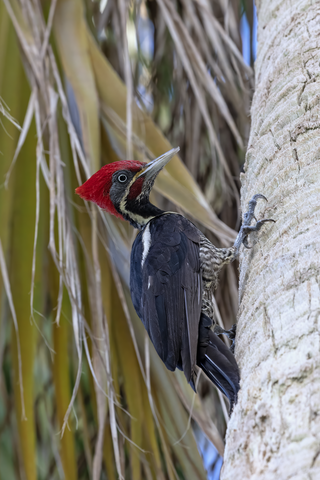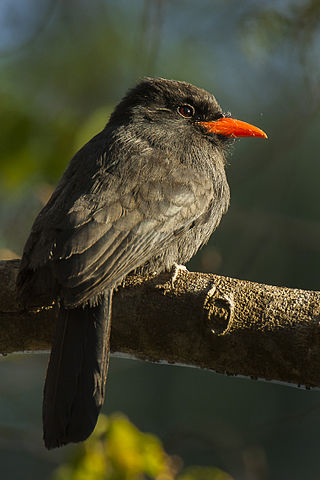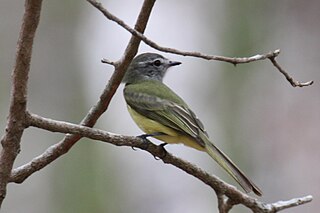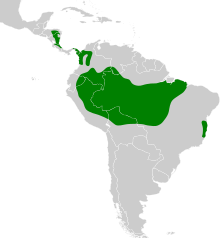
The lineated woodpecker is a very large woodpecker which is a resident breeding bird from southern Mexico to northern Argentina and Trinidad in the Caribbean.

The yellow-rumped cacique is a passerine bird in the New World family Icteridae. It breeds in much of northern South America from Panama and Trinidad south to Peru, Bolivia and central Brazil. However, they have been sighted as far north as Nayarit state in Mexico.

The short-tailed swift is a bird in the Apodidae, or swift family.

The yellow-chinned spinetail is a passerine bird found in the tropical New World from Trinidad and Colombia south to Argentina and Uruguay. It is a member of the South American ovenbird family Furnariidae.

The southern beardless tyrannulet is a small passerine bird in subfamily Elaeniinae of family Tyrannidae, the tyrant flycatchers. It is found in Costa Rica, Panama, in every mainland South American country except Chile, and on Trinidad.

The chestnut-headed oropendola is a New World tropical icterid bird. The scientific name of the species commemorates Johann Georg Wagler, who established Psarocolius, the oropendola genus.

The chestnut-backed antbird is a passerine bird in subfamily Thamnophilinae of family Thamnophilidae, the "typical antbirds". It is found in Colombia, Costa Rica, Ecuador, Honduras, Nicaragua, and Panama.

The spotted puffbird is a species of puffbird in the family Bucconidae, the puffbirds, nunlets, and nunbirds. It is found in Bolivia, Brazil, Colombia, Ecuador, French Guiana, Guyana, Peru, Suriname, and Venezuela.

The black nunbird is a species of near-passerine bird in the family Bucconidae, the puffbirds, nunlets, and nunbirds. It is found in Brazil, French Guiana, Guyana, Suriname, and Venezuela.

The yellow-billed nunbird is a species of near-passerine bird in the family Bucconidae, the puffbirds, nunlets, and nunbirds. It is found in Bolivia, Brazil, Colombia, Ecuador, and Peru.

The black-fronted nunbird is a species of near-passerine bird in the family Bucconidae, the puffbirds, nunlets, and nunbirds. It is found in Bolivia, Brazil, Colombia, Ecuador, and Peru.

The grey-cheeked nunlet is a species of near-passerine bird in the family Bucconidae, the puffbirds, nunlets, and nunbirds. It is found in Colombia and Panama.

The barred forest falcon is a species of bird of prey in subfamily Herpetotherinae of family Falconidae, the falcons and caracaras. It occurs from southern Mexico south through most of Central America and in every mainland South American country except Chile and Uruguay.

The streak-backed canastero is a species of bird in the Furnariinae subfamily of the ovenbird family Furnariidae. It is found in Argentina, Bolivia, Colombia, Ecuador, Peru, and Venezuela.

The black-banded woodcreeper is a sub-oscine passerine bird in subfamily Dendrocolaptinae of the ovenbird family Furnariidae. It is found discontinuously from Chiapas, Mexico, to Panama and in every mainland South American country except Chile and Uruguay.

The sepia-capped flycatcher is a species of bird in the family Tyrannidae, the tyrant flycatchers. It is found in Mexico, every Central American country except El Salvador, and every mainland South American country except Chile; it is known in Uruguay as a vagrant.

The greenish elaenia is a species of bird in subfamily Elaeniinae of family Tyrannidae, the tyrant flycatchers. It is found in Mexico, every Central American country, and every mainland South American country except Chile and French Guiana. It has also occurred as a vagrant in southern Texas.

The rufous-rumped antwren is a species of bird in subfamily Euchrepomidinae of family Thamnophilidae, the "typical antbirds". It is found in Colombia, Costa Rica, Ecuador, French Guiana, Guyana, Panama, Peru, Suriname, and Venezuela.

The white-fronted tyrannulet is a species of bird in subfamily Elaeniinae of family Tyrannidae, the tyrant flycatchers. It is found in Bolivia, Colombia, Costa Rica, Ecuador, Panama, Peru, and Venezuela.

Galbuli is one of the two suborders of the order Piciformes. It includes two families, Bucconidae (puffbirds) and Galbulidae (jacamars), both restricted to the Neotropics.

























